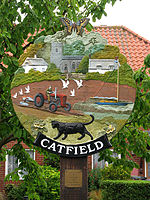Ludham

Ludham is a village and civil parish in the English county of Norfolk, in the Norfolk Broads, at the end of a dyke leading to Womack Water and flowing into the River Thurne. It lies 1.5 miles (2.4 km) to the East of Ludham Bridge, which is on the River Ant. It covers an area of 12.18 km2 (4.70 sq mi) and had a population of 1,301 in 582 households at the 2001 census, the population reducing to 1,278 at the 2011 census. For the purposes of local government, it falls within the district of North Norfolk. The villages name origin is unsure possibly, 'Luda's homestead/village' but perhaps, 'homestead/village on the Hlude (= noisy one)', an old name for Womack Water. It is part of the Ludham - Potter Heigham NNR, a national nature reserve. The village gave its name to a Ham-class minesweeper, HMS Ludham and also, in geology, to an age/stage (the Ludhamian) in the British regional subdivision of the Pleistocene Series/Epoch. It also effectively gives its name to the preceding age/underlying stage known as the Pre-Ludhamian.
Excerpt from the Wikipedia article Ludham (License: CC BY-SA 3.0, Authors, Images).Ludham
Yarmouth Road, North Norfolk Ludham
Geographical coordinates (GPS) Address Nearby Places Show on map
Geographical coordinates (GPS)
| Latitude | Longitude |
|---|---|
| N 52.70988 ° | E 1.53551 ° |
Address
Yarmouth Road
Yarmouth Road
NR29 5QF North Norfolk, Ludham
England, United Kingdom
Open on Google Maps









